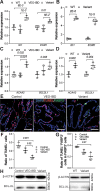This is a preprint.
TNFSF13 insufficiency disrupts human colonic epithelial cell-mediated B cell differentiation
- PMID: 39386555
- PMCID: PMC11463615
- DOI: 10.1101/2024.09.23.614260
TNFSF13 insufficiency disrupts human colonic epithelial cell-mediated B cell differentiation
Abstract
Cytokines mediating epithelial and immune cell interactions modulate mucosal healing- a process that goes awry with chronic inflammation as in inflammatory bowel disease. TNFSF13 is a cytokine important for B cell maturation and function, but roles for epithelial TNFSF13 and putative contribution to inflammatory bowel disease are poorly understood. We evaluated functional consequences of a novel monoallelic TNFSF13 variant using biopsies, tissue-derived colonoids and induced pluripotent stem cell (iPSC)-derived colon organoids. TNFSF13 variant colonoids exhibited a >50% reduction in secreted TNFSF13, increased epithelial proliferation, and reduced apoptosis, which was confirmed in iPSC-derived colon organoids. Single cell RNA-sequencing, flow cytometry, and co-immunoprecipitation identified FAS as the predominant colonic epithelial receptor for TNFSF13. Imaging mass cytometry revealed an increase in epithelial-associated B cells in TNFSF13 variant colon tissue sections. Finally, TNFSF13 variant colonoids co-cultured with memory B cells demonstrated a reduction in the production of IgA+ plasma cells compared to control colonoid co-cultures. Our findings support a role for epithelial TNFSF13 as a regulator of colonic epithelial growth and epithelial crosstalk with B cells.
Conflict of interest statement
CONFLICTS OF INTEREST The authors disclose no conflicts.
Figures






References
-
- Neurath MF. Cytokines in inflammatory bowel disease. Nat Rev Immunol. 2014;14(5):329–42. - PubMed
-
- Kuenzig ME, Fung SG, Marderfeld L, Mak JWY, Kaplan GG, Ng SC, et al. Twenty-first Century Trends in the Global Epidemiology of Pediatric-Onset Inflammatory Bowel Disease: Systematic Review. Gastroenterology. 2022;162(4):1147–59 e4. - PubMed
-
- Levine A, Griffiths A, Markowitz J, Wilson DC, Turner D, Russell RK, et al. Pediatric modification of the Montreal classification for inflammatory bowel disease: the Paris classification. Inflamm Bowel Dis. 2011;17(6):1314–21. - PubMed
Publication types
Grants and funding
LinkOut - more resources
Full Text Sources
Molecular Biology Databases
Research Materials
Miscellaneous
